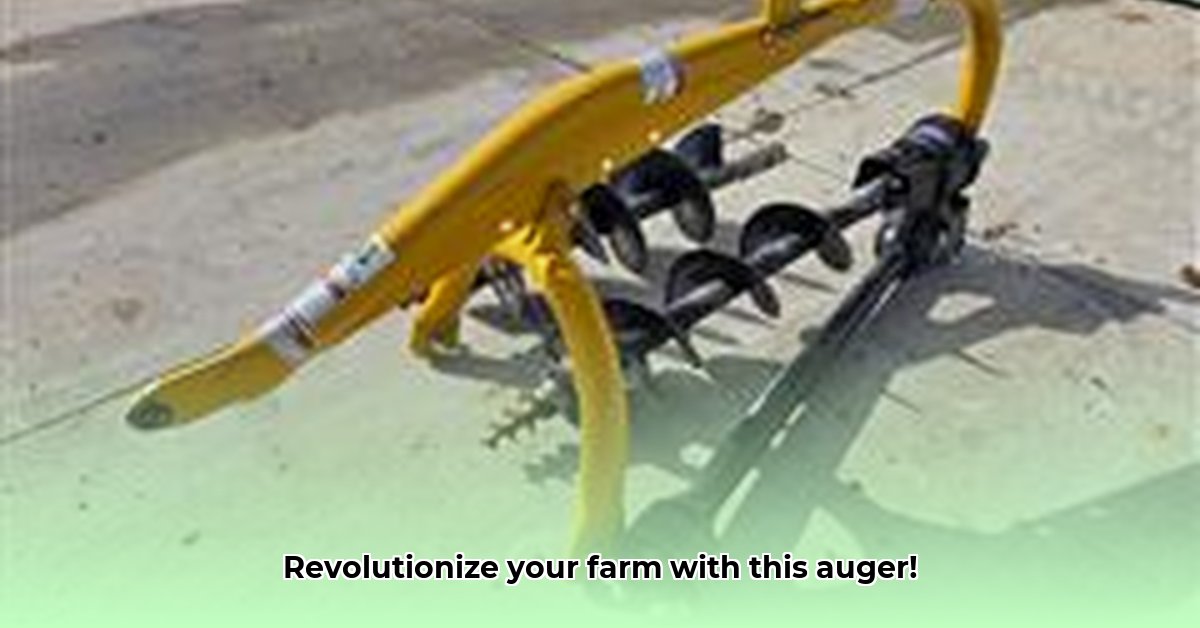
Choosing the Right Auger for Your Sustainable Farming Operation
Selecting the appropriate Tractor Supply 3-point auger is paramount for efficient and sustainable farming practices. The wrong choice can lead to soil compaction, wasted fuel, and ultimately, reduced yields. Before making a purchase, consider these key factors:
For more information on 3-point hitch implements, check out this helpful resource: 3-point hitch implements.
1. Intended Use: Will the auger primarily be used for planting, soil aeration, or sample collection? Different augers are optimized for specific tasks. A planting auger, for example, may have a different design than one used for soil aeration.
2. Auger Size and Soil Type: Larger augers offer faster digging but can compact the soil excessively, hindering root growth. Smaller augers are gentler, but slower. A heavier clay soil requires a more robust auger than lighter sandy soil. "The choice is heavily dependent on soil type," states Dr. Emily Carter, Agricultural Engineer, University of California, Davis. "Compressible soils need a lighter touch."
3. Auger Length and Planting Depth: The length of the auger dictates the depth of your planting holes. Match this to the specific requirements of your chosen crops. Deeper rooting plants necessitate longer augers. Failing to consider this can lead to uneven growth.
4. Tractor Compatibility: Ensure the auger's weight and power requirements align with your tractor's capabilities. Overworking your tractor leads to increased fuel consumption and potential mechanical failure. Always check your tractor's specifications before selecting an auger. "Overloading your tractor is a common mistake," notes John Miller, a veteran farmer from Iowa. "It's always better to err on the side of caution."
Setting Up and Using Your Auger: A Practical Guide
Proper setup and operation are critical for both efficiency and preventing equipment damage. Follow these steps meticulously:
Secure Attachment: Carefully attach the auger to your tractor's three-point hitch, following the manufacturer's instructions precisely. Improper attachment is a leading cause of auger failure.
Gradual PTO Engagement: Slowly engage the power take-off (PTO) shaft, gradually increasing the speed as needed. Sudden engagement can damage the auger's gears and your tractor’s transmission.
Controlled Digging: Maintain a consistent speed and avoid jerky movements. Uneven drilling leads to uneven planting depths and reduced yields.
Depth Regulation: Utilize the auger's depth control mechanism to maintain consistent planting depth. Inconsistencies here can lead to unequal crop growth and harvest yields.
Fuel Efficiency Monitoring: Observe your tractor's fuel consumption. Minimize idling and optimize operational techniques for higher fuel efficiency. This contributes to lower operating costs and reduced environmental impact. "Fuel efficiency is a critical component of sustainable agriculture," says Dr. Sarah Chen, Professor of Sustainable Agriculture, Cornell University. "Every drop counts."
Maximizing Efficiency and Sustainability: Best Practices
Beyond the mechanics of using the auger, several practices enhance efficiency and promote sustainable farming:
Pre-Planning: Optimize your planting layout and spacing before operation, maximizing the land's use and minimizing fuel consumption. This strategy directly relates to increased productivity.
Soil Testing: Analyze your soil to determine its nutrient content, pH level, and other properties. Amendments may be necessary before planting to ensure optimal crop health. "Knowledge of your soil is the foundation of sustainable farming," asserts Dr. David Lee, Soil Scientist, USDA.
Regular Maintenance: Regularly inspect, clean, and lubricate your auger to extend its lifespan and optimize performance. Regular maintenance reduces downtime and prevents unexpected repairs.
Fuel-Efficient Operation: Employ techniques that minimize idling and optimize tractor performance for reduced fuel consumption. This promotes both cost savings and environmental responsibility.
Comparing Tractor Supply 3-Point Augers: Key Considerations
While the Tractor Supply brand offers excellent value, comparing its augers with other options is crucial. Factors such as build quality, durability, and specific features influence your overall return on investment (ROI). Consider reading reviews and comparing specifications before committing to a purchase. Ensure that any auger you select aligns with your budget and your specific needs.
Key Takeaways:
- Proper auger selection is crucial for efficient and sustainable farming.
- Careful operation and meticulous maintenance extend the auger's lifespan and minimize environmental impact.
- Prioritize fuel efficiency and soil health for long-term productivity.
This detailed guide helps ensure you get the most from your Tractor Supply 3-point auger, contributing to a more efficient, sustainable, and profitable farming operation.